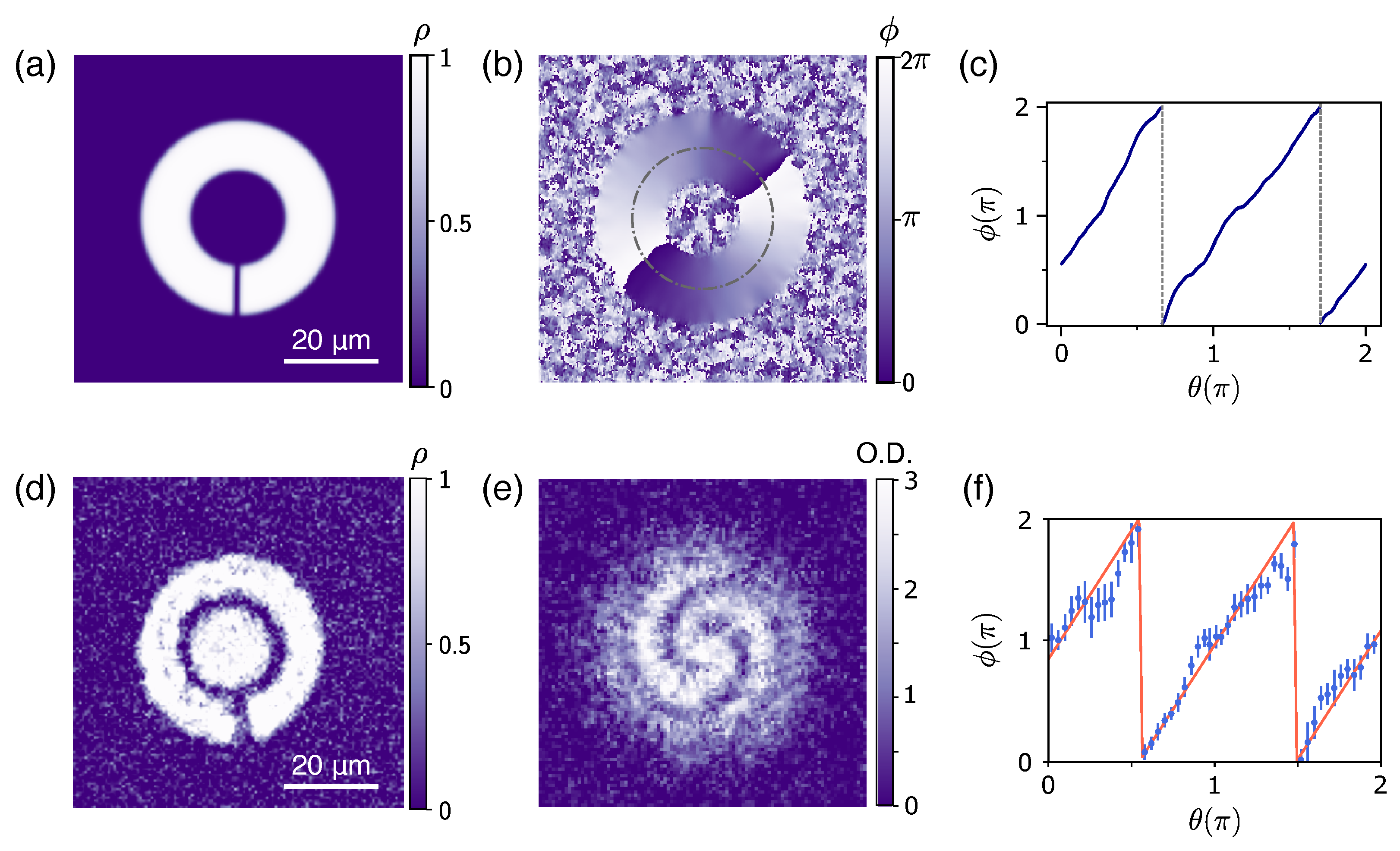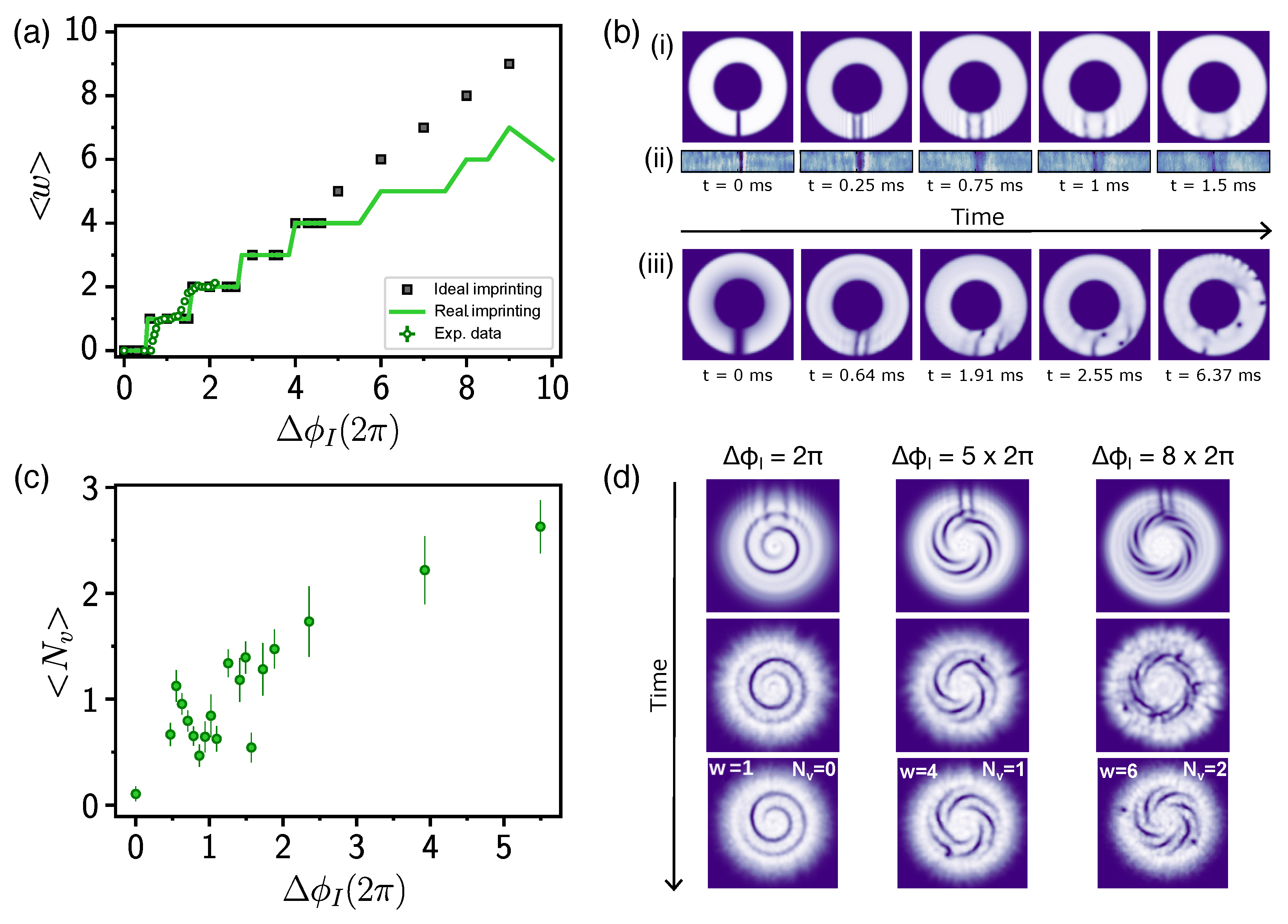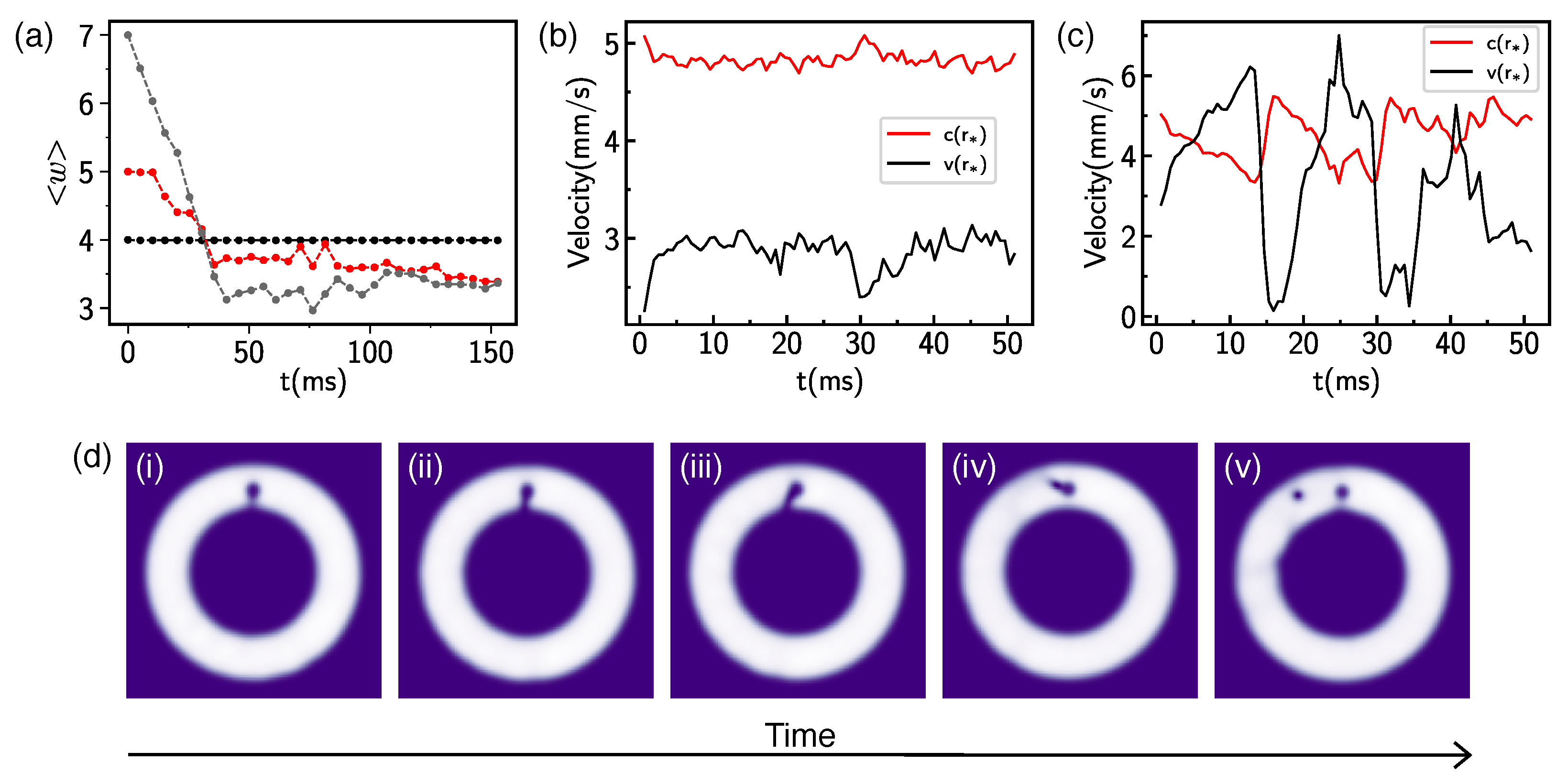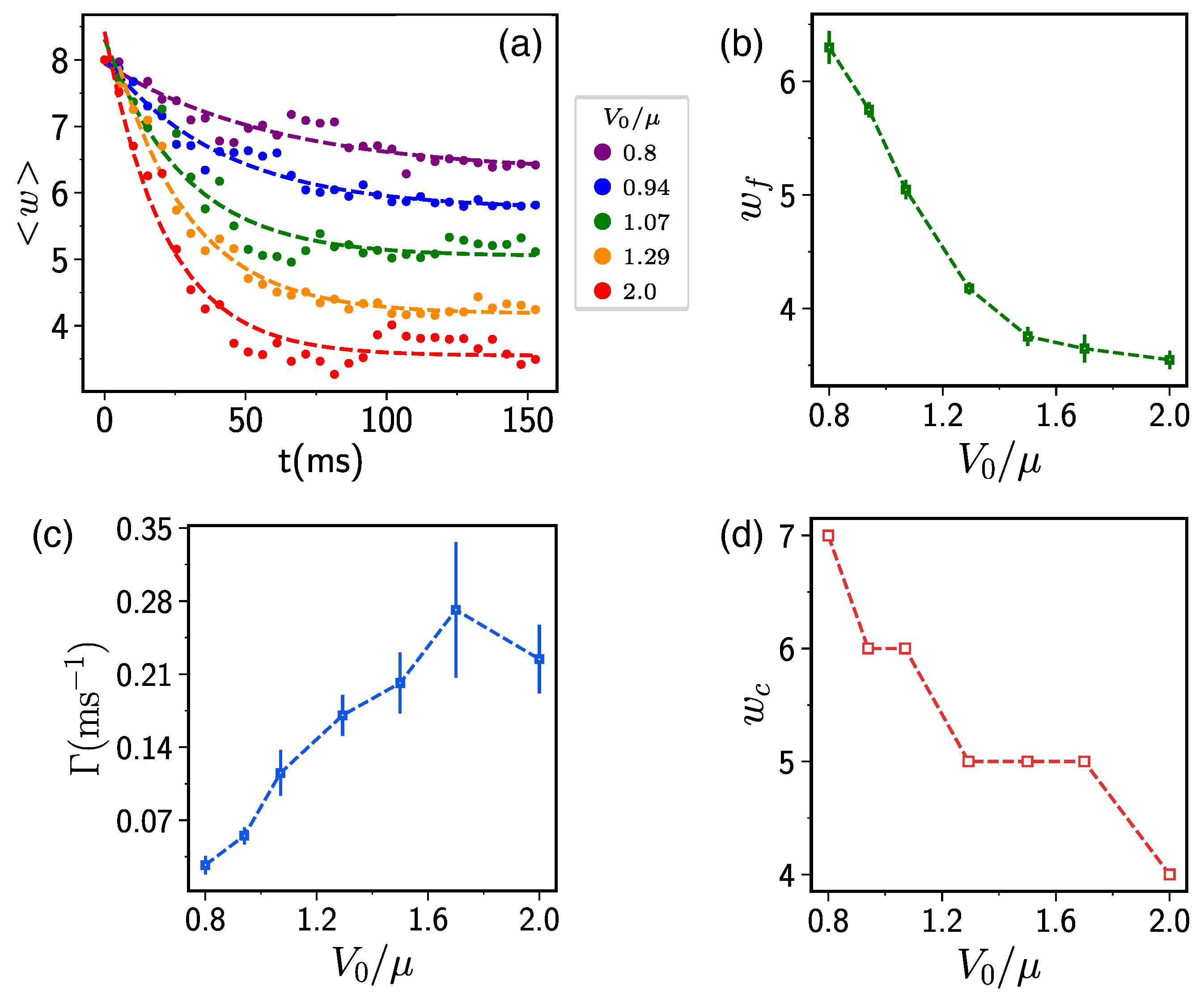3.1. Numerical and Experimental Measurement of the Ring Winding Number
From the solution of the GPE equation of Equation (
1), we extract the density
of the atomic cloud and its phase
by considering the Madelung representation of the wave function
. In
Figure 1a,b, we report the 2D density and phase of the ring superfluid after a total imprinted winding of
performed with the realistic imprinting procedure. The superfluid ring shows a density depletion corresponding to the gradient discontinuity, caused by the sharp anti-gradient in the imprinted profile of Equation (
5). The same perturbation is also observed in the experimental superfluid density reported in
Figure 1d, acquired by imaging in situ the atomic cloud immediately after the imprinting of
. As will be discussed in detail in the next section, the density excitations produced by the imperfections of the imprinting gradient set the effective limit on the maximum winding number we can excite.
Whereas the 2D superfluid density provides information on the imprinting-induced density excitations on the cloud, the phase profile of
Figure 1b measures the circulation in the ring. The winding number of the superfluid ring is indeed encoded in the number of
-jumps performed by the phase in the regions of non-zero density, where this quantity is well defined. In particular,
Figure 1b shows two phase jumps, as clearly illustrated in the azimuthal profile of
reported in
Figure 1c, signaling a winding number
in the ring. More quantitatively, from the 2D profile of the superfluid phase we can calculate the mean circulation as
, where
is the velocity of the superfluid.
Experimentally, the phase of the ring is not an accessible quantity as it is for numerical simulations. However, the interferometric technique already discussed accesses the relative phase of the ring with respect to the disk superfluid at rest, such that from the interferograms we can measure the ring winding number. In
Figure 1e, we report the interferogram obtained after the imprinting of
. The two clockwise spirals in such an image reveals a circulation of
in the clockwise direction. From the sinusoidal fit of the radial profile of the interference pattern in the interferograms [
16], the experimental azimuthal trend of the relative phase can be extracted (see
Figure 1f). The local relative phase displays the same linear trend, modulus
, exhibited by the numerical phase of
Figure 1c, demonstrating that the two methods provides the same information on the winding number. We note that, as long as there are no vortices in the ring density, the mean circulation measured from the numerical phase profile coincides with the winding number we can extract form the interferogram, with the number of spirals appearing in the interference pattern. However, when vortices are traveling in the ring density, the extracted value of the mean circulation is affected by the local phase winding around the vortices, and the values of
extracted from the mean circulation and from the interferograms may slightly mismatch. In particular, the interferogram patterns measure the winding number of the internal edge of the ring, where the interference with the phase reference occurs, whereas the mean circulation accounts for the whole phase profile in the ring.
3.2. The Maximum Circulation State
The experimental data reported in Ref. [
16] show that the maximum circulation excitable with a single phase imprinting is
in the BEC regime. This value corresponds to superfluid velocities well below the speed of sound in every region of the ring, as the velocity of the superfluid at the inner ring radius is roughly
. To understand the origin of such a maximum winding number, we numerically study the imprinting procedure for both ideal and realistic imprinting. In both cases, we measure the excited ring circulation from the numerical interferograms and compare it with the experimental imprinting characterization in
Figure 2a. For both experimental (green symbols) and numerical results obtained with either of the two imprinting methods (green line for realistic, black symbols for ideal imprinting), the measured winding
displays the typical step-like trend arising from the quantized nature of the circulation. However, whereas with the ideal imprinting, the measured winding keeps increasing, the excited circulation with the realistic imprinting saturates at
for large
, in qualitative agreement with the experimentally observed
in the BEC regime [
16]. In particular, the numerical simulation for
with the realistic imprinting show that, initially, a circulation of
is excited in the ring, but it quickly decays to a lower value in a timescale of a few milliseconds, consistent with the experimental observations [
16]. Such a decay is never observed in the numerical results employing the ideal imprinting, which is able to excite stable circulation state for arbitrarily large
. After an ideal imprinting of a phase multiple of
, the atomic density is observed to be unperturbed, with no density excitations that could limit the imprinted circulation.
On the other hand, both in the experimental in situ density profile and in the numerical one after the realistic imprinting procedure, a density depletion is clearly visible at the location of the sharp anti-gradient of the imprinting profile. In order to understand the connection of such a density perturbation with the observed
, we follow its evolution in time.
Figure 2b shows the short-time dynamics of the ring superfluid density in the
-plane for
(i—numerical, ii—experimental) and for
(iii). For small
, the initial density cut decays into two sound waves propagating in opposite directions, as observed both numerically and experimentally in
Figure 2b(i,ii). The presence of these sound waves only generates some density fluctuations and therefore it does not affect the circulation in the ring, which is observed to be stable to
. On the other hand, for larger
, which corresponds to longer imprinting time, the extension of the initial density depletion increases (see
Figure 2b(iii),
ms). In this case, the decay of such a density perturbation leads to larger amplitude sound waves, which, favored also by the larger superfluid velocity, triggers the entrance of vortices from both the inner and the outer edge of the ring. As a vortex enters the bulk density from the inner ring radius, it removes one circulation quantum from the local ring current, causing the imprinted circulation state to decay to a lower value. The presence of vortices in the superfluid density as a consequence of the imprinting is also observed experimentally, as reported in
Figure 2c. In particular, we find that the average number of vortices
detected after the imprinting grows as a function of the imprinted phase difference, and it is non-zero for small
.
The effect of the density-depletion decay on the circulation in the ring is clearly summarized in
Figure 2d, where we report the numerical interferograms as a function of time after a realistic imprinting of
. In the first case, the density depletion decay introduces only sound waves in the ring superfluid, which quickly decay out without affecting the circulation state, which is always measured to be
in the interferograms. On the other hand, for larger
, the density depletion decay causes vortices to enter the ring superfluid density, which in turn induce the circulation state to decay to a lower value. In the case of
, the system reaches a new equilibrium in approximately 50 ms, and the interferogram at this time shows the coexistence of a circulation of
and one vortex. For
, a larger time is needed to reach the new equilibrium, but eventually the system stabilizes to a circulation of
with two vortices, as shown in the interferogram at
ms. We note that in both
cases, the interferograms taken at intermediate time before reaching the equilibrium display a higher number of vortices, as they also account for the ones that entered the bulk from the outer ring, which do not affect the extracted ring winding number and quickly leave the ring density.
In conclusion, the density excitations introduced by the anti-gradient in the imprinting profile set the limit of the maximum circulation state we can populate. Experimentally, it is observed that increases with increasing , confirming that the vortices emitted from the inner ring are responsible for the circulation state decay for large . Rings with smaller present a higher superfluid velocity at the inner ring radius, as . The critical velocity for vortex emission from the inner ring radius is therefore overcome for smaller , leading to a lower maximum stable circulation state in the ring.
Figure 2c shows a non-zero number of vortices in the superfluid density even for
, when the imprinted circulation does not show any decay. These are mainly vortices entering the bulk from the outer ring, not perturbing the ring current, but they can also arise from the decay of a soliton-like excitation we introduce in the ring when imprinting
, with
k integer. Under this condition, the depletion introduced by the imprinting has the phase profile of a soliton and, similarly to a soliton, it decays into a vortex–antivortex pair [
25,
26]. A comparison between the short-time dynamics for the numerical and experimental in situ density profile after an imprinting of
is reported in
Figure 3a,b. In both cases we observe the soliton to bend, due to the velocity difference between the outer and inner edge of the superfluid, undergoing the so-called snake-instability to finally break into a vortex–antivortex pair [
27,
28], which has opposite circulation and propagates in the opposite direction. Both the numerical and the experimental interferograms obtained 50 ms after the imprinting measure
, signaled by an interference pattern with concentric rings [see
Figure 3c,d]; whereas in the numeric one, the presence of a vortex is clearly evident, in the experimental one it is less striking. Because of its proximity to the outer edge of the ring, the antivortex is more sensible to the presence of thermal effects or other experimental fluctuations that induce it to leave the bulk density faster in the experiment with respect to
GPE simulations. A peak around
is clearly visible in
Figure 2, as here vortices are counted
ms after the imprinting pulse and are still present in the superfluid density. We note that for an imprinting of
, a soliton is excited also for the ideal numerical imprinting procedure, showing a similar decay dynamic to the one illustrated in
Figure 2. In fact, these solitonic states are the excitations that separate two consecutive circulation states, as also found in Ref. [
29]. In conclusion, when imprinting a non-integer multiple of
, the phase-structured density excitations produced at the gradient discontinuity always evolve into vortices, which then propagate on top of the ring current (if present), without further perturbing it.
3.3. Supercurrent Decay Induced by the Obstacle
In this section we focus on the effect of an externally introduced localized defect on the ring persistent current. Throughout this section, we employ the ideal imprinting method in the numerical simulation in order to study the dissipation of the current introduced only by the obstacle. We introduce the defect potential of Equation (
6) at time
and we monitor the evolution of the ring current, extracted from the 2D phase profile as the mean circulation.
Figure 4a shows the numerical results for an obstacle height of
and initial circulations of
. Similar to the experimental and theoretical findings of Ref. [
16], we observe the emergence of a critical circulation: initial states of
are unperturbed by the obstacle, whereas for
, the current decays down to a lower circulation, and it achieves its final value
in timescales of a hundred milliseconds. In particular, for
as in
Figure 4a, the critical circulation is
. Consistent with the results reported in Ref. [
16], obtained for a smaller
, the supercurrent decay is observed to happen over a faster timescale for larger
. Furthermore, as observed in Ref. [
16] and as shown in
Figure 4d, the current decay happens via the emission of quantized vortices that enter the bulk superfluid through the low-density channel between the obstacle and the inner ring radius.
To understand the vortex emission mechanism, we numerically compute the superfluid velocity
v and the local speed of sound
c at a point
in the middle between the defect position and
.
Figure 4b,c show the results for the two values of
(b) and
(c). Consistent with the expected velocity trend
, increasing the value of
leads to larger values of the initial superfluid velocity. For
, we observe the local superfluid velocity, after a small initial increase, to saturate to a plateau value lower than
c. However, for
, the creation of the low-density channel close to the defect leads the local superfluid velocity to increase until its value exceeds the local speed of sound
, which, on the other hand, is decreasing, and a vortex enters the bulk density. When leaving the region at
, the vortex causes a phase slip that decreases the superfluid velocity
. Furthermore, in the region crossed by the vortex, the local circulation is decreased by one unit. In the
case reported here, two vortices are emitted corresponding to the first two superfluid velocity maxima, while the third one corresponds to the emission of only sound waves. After these vortex emission dynamics, the superfluid velocity reaches a smaller value than its initial one, i.e., the ring current is dissipated.
Finally, we report a numerical study of the effect of the vortex height on the current decay dynamics for
. As reported in
Figure 5a, increasing
leads to a faster current decay and to a lower final circulation. We quantitatively analyze the effect of the obstacle height by performing an exponential fit of the numerical data with the function
(dashed lines of
Figure 5a). The fit results obtained for the final circulation
are reported in
Figure 5b. To compare the decay timescales under different
, we account for the different values of
and define the winding decay rate
, plotted in
Figure 5c. The decrease in
and the almost monotonic increase in
in the explored range of
results from the microscopic dynamics of the vortex emission process. In order to better understand their dependence on the defect height, we extract the trend of the critical circulation
as a function of the defect height, as reported in
Figure 5d. We find that, on average,
decreases with
, rapidly in the region of
and more gently for higher obstacles. This leads to an increase in the vortex emission frequency for fixed
as it increases with
[
16]. In particular, for
, the vortices are emitted periodically roughly every
ms, whereas for
, the period for vortex emission is around
ms. Furthermore, the total number of vortices emitted is, on average, larger for higher
, as higher
determines a larger increase in the superfluid velocity in the channel between the obstacle and the inner ring radius. More phase slippage in the superfluid velocity is therefore needed to finally reduce the superflow below the critical value of the local speed of sound, leading to an increased decay rate because of the accumulative effect of many vortices emission events [
30]. In addition, for large
, the stronger vortex–defect interaction induces each vortex to leave the obstacle region at a larger radius, thus yielding to a faster decrease in the mean circulation. We note that we expect that increasing the barrier width instead of its height would similarly lead to a lower critical circulation and a faster mean circulation decay in time.
The effect of the defect in the current dynamics can also be interpreted under the parabolic washboard potential representation. That is, the obstacle in the superfluid density lowers the energy barrier separating the circulation states w and from one another, such that , which defines the critical circulation. For increasing defect height, then, the barrier for a given w gets lower, provoking the decrease in . We can estimate the effect of the defect for different by calculating from the numerical simulation results, as the state is stable under all the conditions we explored. In particular, we define as the difference between the total energy of the system after the imprinting of and . We find that , implying that increasing the defect height increases the probability of a vortex to enter the ring superfluid. Interestingly, we note that the ratio of the energy barriers is compatible with the ratio between the observed at the two obstacle heights.











